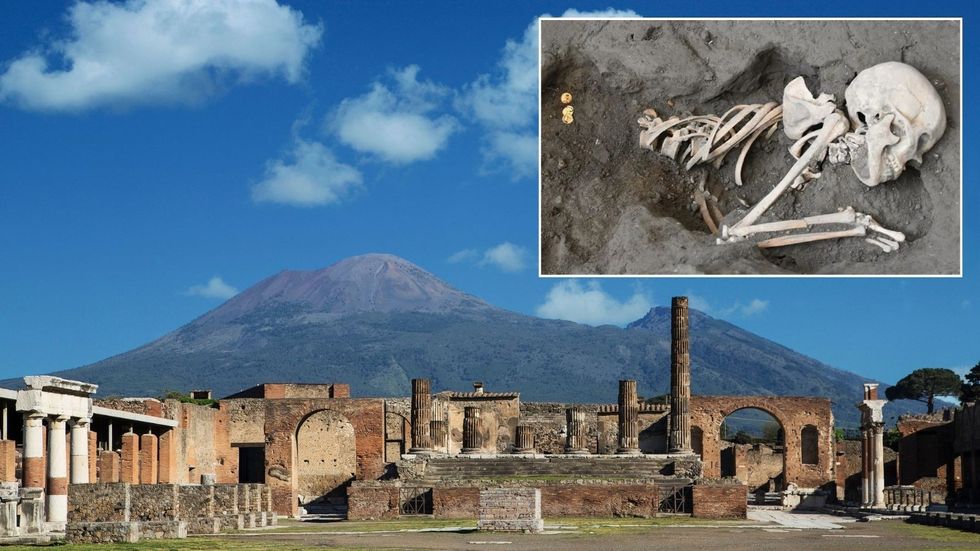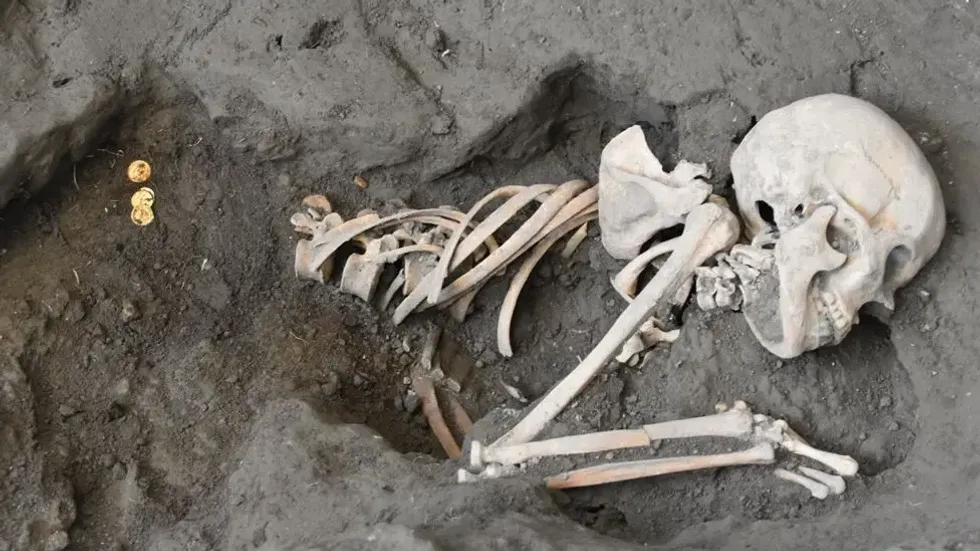Georgina Cutler
Guest Reporter
Archaeologists have unearthed a "once-in-a-century" discovery in the ancient Roman city of Pompeii.
In a spectacular find, a sumptuous private bathhouse had remained buried under volcanic debris for 2,000 years.
The discovery includes a suite of hot, warm and cold rooms adorned with exquisite artwork, making it potentially the largest private bathhouse ever discovered in Pompeii.
The spa-like complex sits at the heart of a grand residence that has been excavated over the past two years.

"It's these spaces that really are part of the 'Pompeii effect' - it's almost as if the people had only left a minute ago," said Dr Gabriel Zuchtriegel, director of the Archaeological Park of Pompeii.
The bathhouse, believed to belong to influential Pompeii politician Aulus Rustius Verus, represents the pinnacle of Roman luxury.
"There are just a few houses that have a private bath complex, so it was something really for the wealthiest of the wealthy," Zuchtriegel explained.
The most impressive feature is the frigidarium, or cold room, which houses a massive plunge pool capable of accommodating 20-30 people.
The room is surrounded by striking red columns and decorated with frescoes depicting athletes.
Zuchtriegel added: "In the hot summers, you could sit with your feet in the water, chatting with your friends, maybe enjoying a cup of wine."
Visitors to the bathhouse would begin their journey in a changing room featuring vibrant red walls and a mosaic floor inlaid with marble from across the Roman Empire.
LATEST DEVELOPMENTS:
The hot room came next, offering a sauna-like experience with its suspended floor allowing hot air to circulate beneath and through cavity walls.
The warm room followed, decorated with bright paintings, where bathers would have oil applied and scraped off with a curved tool called a strigil.
The final stop was the cold room, where guests could cool off in the grand plunge pool amidst the athletic-themed frescoes and red columns.
The excavation also revealed a tragic scene, with two skeletons discovered in a cramped, sparsely decorated room.
The remains belonged to a woman aged between 35 and 50, found curled in a foetal position on a bed, and a younger man in his teens or early 20s who was crushed by a collapsing wall.
"The woman was still alive while he was dying - imagine the trauma - and then this room filled with the rest of the pyroclastic flow, and that's how she died," explains Dr Sophie Hay, an archaeologist at Pompeii.
Analysis revealed the young man's bones showed signs of wear, suggesting he was of lower status, possibly a slave.

The woman's bones and teeth were in better condition, indicating she was likely of higher social standing.
The woman's final moments were captured in the precious items she clutched: gleaming gold and silver coins alongside exquisite jewellery.
These treasured possessions, now kept in Pompeii's vault, include delicate gold and natural pearl earrings, necklace pendants, and intricately etched semi-precious stones.
The young man was found holding only keys.
"When we find this kind of object, the distance from ancient times and modern times disappears," says archaeologist Dr Alessandro Russo.
The items were discovered alongside an assortment of objects on a marble table top in the room - including glassware, bronze jugs and pottery - perhaps gathered as the pair sought refuge from the eruption.
Slaves were forced to work in unbearable conditions, stoking the furnace that heated the water and kept the system running.
"The most powerful thing from these excavations is that stark contrast between the lives of the slaves and the very, very rich," says Dr Sophie Hay.
"A wall is all that could divide you between two different worlds."
The excavation is entering its final weeks, though new discoveries continue to emerge from the volcanic ash.
Limited numbers of visitors are currently allowed to view the ongoing dig, with plans to fully open the site to the public in the future.
"Every day here is a surprise," says Dr Anna Onesti, director of the excavation.
"Sometimes in the morning I come to work thinking that it's a normal working day - and then I discover we found something exceptional."
"It's a magic moment for the life of Pompeii, and this excavation work offers us the possibility to share this with the public."
Find Out More...
In a spectacular find, a sumptuous private bathhouse had remained buried under volcanic debris for 2,000 years.
The discovery includes a suite of hot, warm and cold rooms adorned with exquisite artwork, making it potentially the largest private bathhouse ever discovered in Pompeii.
The spa-like complex sits at the heart of a grand residence that has been excavated over the past two years.

"It's these spaces that really are part of the 'Pompeii effect' - it's almost as if the people had only left a minute ago," said Dr Gabriel Zuchtriegel, director of the Archaeological Park of Pompeii.
The bathhouse, believed to belong to influential Pompeii politician Aulus Rustius Verus, represents the pinnacle of Roman luxury.
"There are just a few houses that have a private bath complex, so it was something really for the wealthiest of the wealthy," Zuchtriegel explained.
The most impressive feature is the frigidarium, or cold room, which houses a massive plunge pool capable of accommodating 20-30 people.
The room is surrounded by striking red columns and decorated with frescoes depicting athletes.
Zuchtriegel added: "In the hot summers, you could sit with your feet in the water, chatting with your friends, maybe enjoying a cup of wine."
Visitors to the bathhouse would begin their journey in a changing room featuring vibrant red walls and a mosaic floor inlaid with marble from across the Roman Empire.
LATEST DEVELOPMENTS:
- Mysterious medieval stone discs found in Ukraine were used by Vikings as solar compasses
- Mysterious black hole leaves scientists baffled after it starts flashing unexpectedly
- 'Incredible' discovery hailed by archaeologists as 4000-year-old Egyptian tomb uncovered
The hot room came next, offering a sauna-like experience with its suspended floor allowing hot air to circulate beneath and through cavity walls.
The warm room followed, decorated with bright paintings, where bathers would have oil applied and scraped off with a curved tool called a strigil.
The final stop was the cold room, where guests could cool off in the grand plunge pool amidst the athletic-themed frescoes and red columns.
The excavation also revealed a tragic scene, with two skeletons discovered in a cramped, sparsely decorated room.
The remains belonged to a woman aged between 35 and 50, found curled in a foetal position on a bed, and a younger man in his teens or early 20s who was crushed by a collapsing wall.
"The woman was still alive while he was dying - imagine the trauma - and then this room filled with the rest of the pyroclastic flow, and that's how she died," explains Dr Sophie Hay, an archaeologist at Pompeii.
Analysis revealed the young man's bones showed signs of wear, suggesting he was of lower status, possibly a slave.

The woman's bones and teeth were in better condition, indicating she was likely of higher social standing.
The woman's final moments were captured in the precious items she clutched: gleaming gold and silver coins alongside exquisite jewellery.
These treasured possessions, now kept in Pompeii's vault, include delicate gold and natural pearl earrings, necklace pendants, and intricately etched semi-precious stones.
The young man was found holding only keys.
"When we find this kind of object, the distance from ancient times and modern times disappears," says archaeologist Dr Alessandro Russo.
The items were discovered alongside an assortment of objects on a marble table top in the room - including glassware, bronze jugs and pottery - perhaps gathered as the pair sought refuge from the eruption.
Slaves were forced to work in unbearable conditions, stoking the furnace that heated the water and kept the system running.
"The most powerful thing from these excavations is that stark contrast between the lives of the slaves and the very, very rich," says Dr Sophie Hay.
"A wall is all that could divide you between two different worlds."
The excavation is entering its final weeks, though new discoveries continue to emerge from the volcanic ash.
Limited numbers of visitors are currently allowed to view the ongoing dig, with plans to fully open the site to the public in the future.
"Every day here is a surprise," says Dr Anna Onesti, director of the excavation.
"Sometimes in the morning I come to work thinking that it's a normal working day - and then I discover we found something exceptional."
"It's a magic moment for the life of Pompeii, and this excavation work offers us the possibility to share this with the public."
Find Out More...
